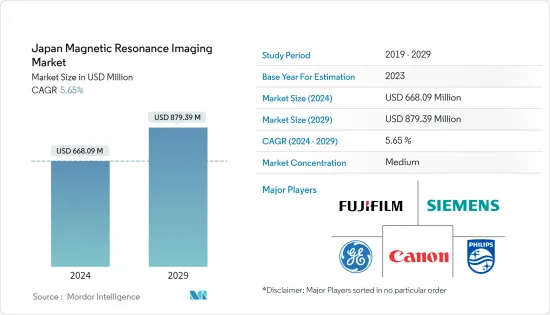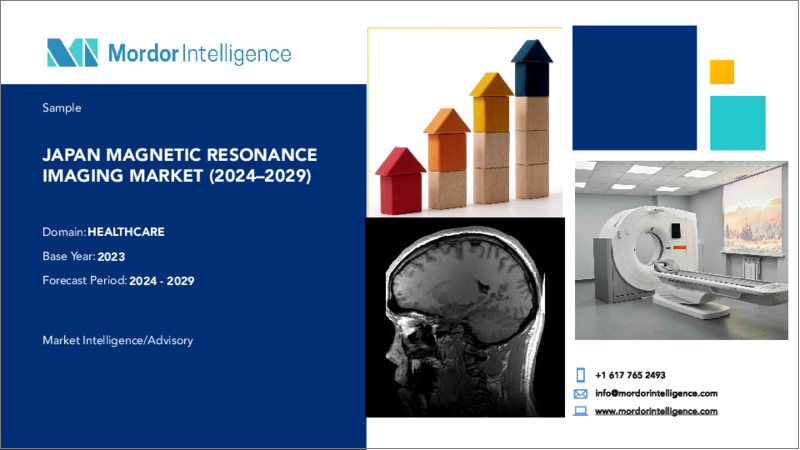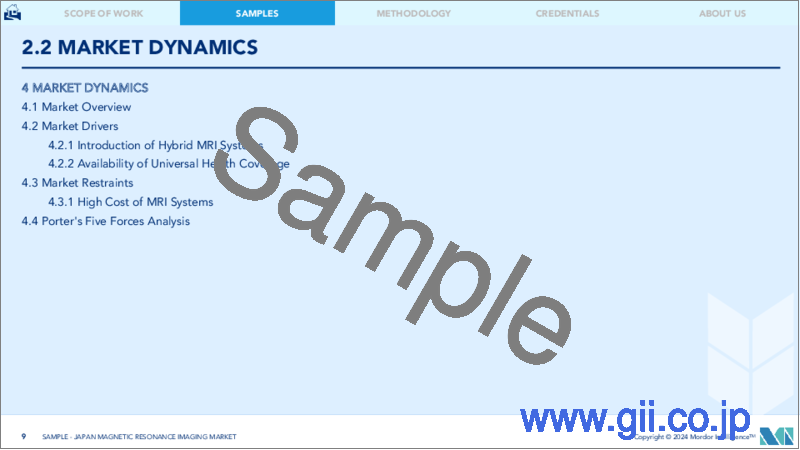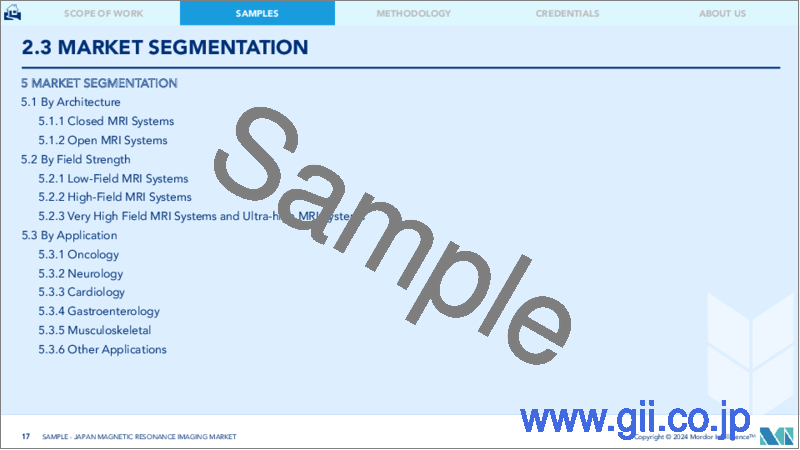|
|
市場調査レポート
商品コード
1437391
日本のMRI(磁気共鳴イメージング):市場シェア分析、業界動向と統計、成長予測(2024~2029年)Japan Magnetic Resonance Imaging - Market Share Analysis, Industry Trends & Statistics, Growth Forecasts (2024 - 2029) |
||||||
カスタマイズ可能
適宜更新あり
|
|||||||
| 日本のMRI(磁気共鳴イメージング):市場シェア分析、業界動向と統計、成長予測(2024~2029年) |
|
出版日: 2024年02月15日
発行: Mordor Intelligence
ページ情報: 英文 87 Pages
納期: 2~3営業日
|
- 全表示
- 概要
- 目次
日本のMRI(磁気共鳴イメージング)市場規模は、2024年に6億6,809万米ドルと推定され、2029年までに8億7,939万米ドルに達すると予測されており、予測期間(2024年から2029年)中に5.65%のCAGRで成長します。

COVID-19感染症のパンデミックは、非常に短期間に長年確立されてきた慣行に混乱を引き起こしました。気候変動やその他の感染症などの問題は、将来さらに深刻な危機や新たな社会リスクを引き起こす可能性があります。これは、病院前ケアシステムや病院内のワークフローなど、脳卒中ヘルスケアに大きな影響を与えています。COVID-19感染症のパンデミック以前は、施設の方針に従って再灌流療法の適応を評価するために脳MRIが主に使用されていました。 Withコロナ期の緊急事態宣言解除後、特に静脈内血栓溶解療法のみを受けた患者においてMRIを受ける患者の割合が増加しました。したがって、MRIイメージングの使用が大幅に増加し、それが日本のMRI市場の成長を促進したことが観察されます。
2021年4月に発表された「男性における無症候性新型コロナウイルス感染症の回復期における急性虚血性脳卒中」と題された研究によると、急性虚血性脳卒中(AIS)は、呼吸器症状を有するCOVID-19感染症患者における神経学的影響として文書化されています。一方、AISは、呼吸器症状のないCOVID-19症患者における晩期合併症として記録されていないです。臨床経過、画像検査、および検査所見からの結果が検索され、比較されました。新型コロナウイルス陽性患者の発生率は高く、これにより日本のMRI市場の需要が高まることが予想されます。
市場の成長を牽引する主な要因には、慢性疾患の負担の増加とそのための画像診断需要の増加、国内の主要企業の存在などが含まれます。さらに、日本は研究集約国であり、磁気共鳴画像法の分野での調査研究により、MRI技術が進歩し、認知度がさらに高まることが期待されています。たとえば、2021年9月に発表された「全身MRIと、1.5Tおよび3TのMRIシステムと統合型PET/CTを使用した非全身MRIと同時登録PET/MRIにおけるTNM期の調査精度の比較」というタイトルの研究結果によると、「小細胞肺がん」、3-Tおよび1.5-Tシステムを使用した全身 MRIおよび同時登録されたPET/MRIは、PET/CTと同等以上の精度を示しますが、3-Tと1.5-T MRIシステム間の違いは考慮されていません。重要な。したがって、日本で調査された市場は、予測期間中に力強い成長を遂げると予想されます。
日本のMRI(磁気共鳴イメージング)市場動向
腫瘍領域は将来的に大幅な成長が見込まれる
MRI(磁気共鳴イメージング)は、体内の腫瘍/がん細胞を検出し、がんが発生し始めた場所から体の別の部分に転移(拡散)した可能性のある兆候を探すために使用できる画像検査です。 MRIシステムは、強力な磁石と電波を使用して、コンピューターで生成された体の詳細な断面画像を作成します。この画像は、後に医師ががん細胞/組織の診断に使用します。
日本はアジア太平洋地域で最も技術的に進んだ国の一つであり、がんの負担が大きい強固なヘルスケア制度を備えており、それが国内の腫瘍学の研究分野の成長を促進しています。例えば、グロボカン2020年報告書によると、日本では2020年に新たながん症例が1,028,658人報告され、5年間に蔓延したがん症例の総数は2,710,728人でした。国内で男女ともに主に診断された主ながんの形態は、結腸直腸がん、肺がん、胃がん、前立腺がん、乳がんでした。さらに、上記の情報源によると、日本ではがんの症例数が2030年までに1,110,549人、2040年までに1,128,057人に達すると予測されており、これにより国内のMRIシステムの需要がさらに増加し、腫瘍学の成長を促進すると予想されています。セグメント。
2021年6月に発表された「乳がんの個人歴を持つ女性における陰性補足スクリーニング後の乳房MRI結果によるインターバルがんの発生」というタイトルの調査結果によると、がん発見率は1000回のスクリーニング検査当たり8.3人、インターバルがん発生率は1.5人だった。 1,000件のスクリーニング検査と多変量解析の結果、間隔がんは、乳がんの第1級家族歴、エストロゲン受容体陰性およびプロゲステロン受容体陰性の原発がん、中等度または顕著な背景実質増強と関連しており、乳がんの遺伝的関連が示唆されています。がんの発生により乳がんの数が増加する可能性があり、このセグメントが成長に向けて推進されます。
日本の磁気共鳴画像産業の概要
日本のMRI(磁気共鳴イメージング)市場は競争が激しく、複数の主要企業で構成されています。市場シェアの点では、現在、いくつかの大手企業が市場を独占しています。しかし、技術の進歩と質の高いサービスの提供により、中規模から中小企業はより低価格の新製品を導入することで市場での存在感を高めています。 Siemens Healthineers、GEヘルスケア、Canon Medical Systems、Philipsヘルスケアなどの企業は、世界のMRI(磁気共鳴イメージング)市場で大きな市場シェアを保持しています。
その他の特典
- エクセル形式の市場予測(ME)シート
- 3か月のアナリストサポート
目次
第1章 イントロダクション
- 調査の前提条件と市場の定義
- 調査範囲
第2章 調査手法
第3章 エグゼクティブサマリー
第4章 市場力学
- 市場概要
- 市場促進要因
- ハイブリッドMRIシステムのイントロダクション
- ユニバーサル・ヘルス・カバレッジの利用可能性
- 市場抑制要因
- MRIシステムの高コスト
- ポーターのファイブフォース分析
- 新規参入業者の脅威
- 買い手の交渉力
- 供給企業の交渉力
- 代替製品の脅威
- 競争企業間の敵対関係の激しさ
第5章 市場セグメンテーション
- アーキテクチャ別
- 密閉型MRIシステム
- オープンMRIシステム
- 磁場強度別
- 低磁場MRIシステム
- 高磁場MRIシステム
- 超高磁場MRIシステム(Very HighおよびUltra-high)
- 用途別
- 腫瘍学
- 神経内科
- 心臓病学
- 消化器科
- 筋骨格系
- その他の用途
第6章 競合情勢
- 企業プロファイル
- Canon Medical Systems Corporation
- Fujifilm Holdings Corporation
- GE Healthcare
- Koninklijke Philips NV
- Siemens Healthineers
- Elekta AB
- United Imaging Healthcare Co. Ltd
- Esaote SpA
- Neusoft Medical Systems Co. Ltd
- Shenzhen anke high-tech co. ltd
第7章 市場機会と将来の動向
The Japan Magnetic Resonance Imaging Market size is estimated at USD 668.09 million in 2024, and is expected to reach USD 879.39 million by 2029, growing at a CAGR of 5.65% during the forecast period (2024-2029).

The COVID-19 pandemic has sparked the disturbance of long-established practices in an extremely short period. Issues such as climate change and other infectious diseases are set to cause even worse crises and new societal risks in the future. It has had a significant impact on stroke healthcare, including the prehospital care system and in-hospital workflow. Before the COVID-19 pandemic, brain MRI was mainly used to evaluate the indication for reperfusion therapy according to the institutional policy. After the lifting of the State of Emergency in the With-COVID-19 period, the proportion of patients undergoing MRI increased, especially in patients who only received intravenous thrombolysis. Therefore, it is observed that the use of MRI imaging significantly increased, which, in turn, boosted the growth of the MRI market in Japan.
According to a study titled 'Acute Ischemic Stroke During the Convalescent Phase of Asymptomatic COVID-2019 Infection in Men', published in April 2021, acute ischemic stroke (AIS) is a documented neurological consequence in COVID-19 infected patients who have respiratory symptoms. AIS, on the other hand, has not been recorded as a late complication in COVID-19 individuals who do not have respiratory symptoms. The results from the clinical course, imaging, and laboratory findings were retrieved and compared. The incidence rate is high in covid-positive patients which are expected to increase the demand for the MRI market in Japan.
Some of the major factors driving the market growth include the rising burden of chronic diseases and increasing demand for diagnostic imaging for the same and the presence of key companies in the country. Furthermore, Japan is a research-intensive country, and research studies in the area of magnetic resonance imaging are further expected to advance the MRI technology and increase more awareness. For instance, according to the research study published in September 2021, titled 'Comparison of Diagnostic Accuracy for TNM Stage Among Whole-Body MRI and Coregistered PET/MRI Using 1.5-T and 3-T MRI Systems and Integrated PET/CT for Non-Small Cell Lung Cancer', whole-body MRI and coregistered PET/MRI using 3-T and 1.5-T systems are as accurate or more accurate than PET/CT, whereas differences between 3-T and 1.5-T MRI systems are not considered significant. Therefore, the market studied in Japan is expected to witness strong growth over the forecast period.
Japan Magnetic Resonance Imaging Market Trends
Oncology Segment is Expected to Witness Significant Growth in Future
Magnetic resonance imaging (MRI) is an imaging test that can be used for the detection of tumor/cancerous cells in the body and to look for signs that cancer may have metastasized (spread) from where it started to another part of the body. MRI system uses powerful magnets and radio waves to make detailed, computer-generated cross-section pictures of the body, which are later used by doctors in the diagnosis of cancerous cell/tissue.
Japan is one of the most technologically advanced countries in the Asia-Pacific region and has a robust healthcare system with a high burden of cancer, which is driving the growth of the studied segment of oncology in the country. For instance, according to the Globocan 2020 report, Japan reported 1,028,658 new cases of cancer in 2020, and the total number of five-year prevalent cases of cancer was 2,710,728. The major forms of cancer, which were majorly diagnosed in the country in both sexes were colorectum, lung, stomach, prostate, and breast cancer. Further, as per the above-mentioned source, it is projected that the cases of cancer will reach 1,110,549 by 2030, and 1,128,057 by 2040 in Japan, which will further increase the demand for MRI systems in the country and drive the growth of the oncology segment.
According to a research study published in June 2021, titled 'Interval Cancers after Negative Supplemental Screening Breast MRI Results in Women with a Personal History of Breast Cancer', the cancer detection rate was 8.3 per 1000 screening examinations, the interval cancer rate was 1.5 per 1000 screening examinations, and the multivariable analysis, interval cancers were associated with a first-degree family history of breast cancer, estrogen receptor- and progesterone receptor-negative primary cancers, and moderate or marked background parenchymal enhancement, which suggests the hereditary linkage of breast cancer, which might lead to a high number of breast cancer, propelling the segment toward growth.
Japan Magnetic Resonance Imaging Industry Overview
The Japan magnetic resonance imaging market is highly competitive and consists of several major players. In terms of market share, a few of the major players currently dominate the market. However, with technological advancements and quality service provisions, mid-size to smaller companies are increasing their market presence by introducing new products at less prices. Companies, like Siemens Healthineers, GE Healthcare, Canon Medical Systems, and Philips Healthcare, hold a significant market share in the global magnetic resonance imaging market.
Additional Benefits:
- The market estimate (ME) sheet in Excel format
- 3 months of analyst support
TABLE OF CONTENTS
1 INTRODUCTION
- 1.1 Study Assumptions and Market Definition
- 1.2 Scope of the Study
2 RESEARCH METHODOLOGY
3 EXECUTIVE SUMMARY
4 MARKET DYNAMICS
- 4.1 Market Overview
- 4.2 Market Drivers
- 4.2.1 Introduction of Hybrid MRI Systems
- 4.2.2 Availability of Universal Health Coverage
- 4.3 Market Restraints
- 4.3.1 High Cost of MRI Systems
- 4.4 Porter's Five Forces Analysis
- 4.4.1 Threat of New Entrants
- 4.4.2 Bargaining Power of Buyers/Consumers
- 4.4.3 Bargaining Power of Suppliers
- 4.4.4 Threat of Substitute Products
- 4.4.5 Intensity of Competitive Rivalry
5 MARKET SEGMENTATION (Market Size by Value - USD million)
- 5.1 By Architecture
- 5.1.1 Closed MRI Systems
- 5.1.2 Open MRI Systems
- 5.2 By Field Strength
- 5.2.1 Low Field MRI Systems
- 5.2.2 High Field MRI Systems
- 5.2.3 Very High Field MRI Systems and Ultra-high MRI Systems
- 5.3 By Application
- 5.3.1 Oncology
- 5.3.2 Neurology
- 5.3.3 Cardiology
- 5.3.4 Gastroenterology
- 5.3.5 Musculoskeletal
- 5.3.6 Other Applications
6 COMPETITIVE LANDSCAPE
- 6.1 Company Profiles
- 6.1.1 Canon Medical Systems Corporation
- 6.1.2 Fujifilm Holdings Corporation
- 6.1.3 GE Healthcare
- 6.1.4 Koninklijke Philips NV
- 6.1.5 Siemens Healthineers
- 6.1.6 Elekta AB
- 6.1.7 United Imaging Healthcare Co. Ltd
- 6.1.8 Esaote SpA
- 6.1.9 Neusoft Medical Systems Co. Ltd
- 6.1.10 Shenzhen anke high-tech co. ltd





